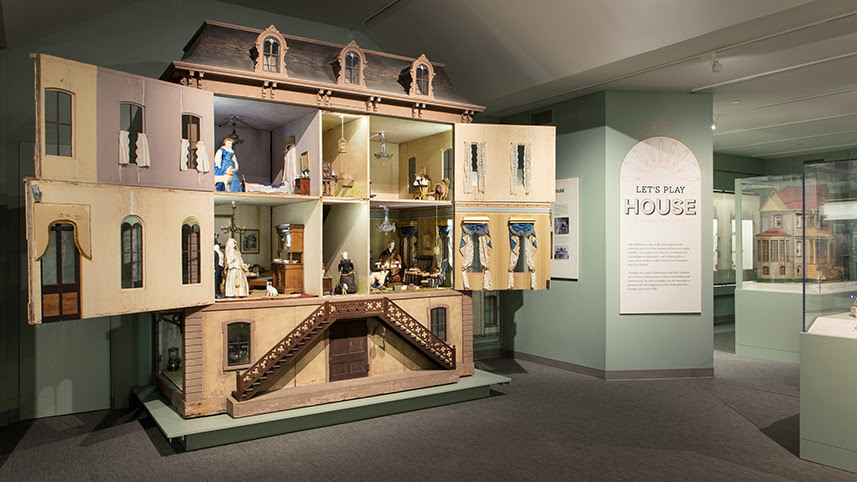
21 Sep Ancestors Newsletter- September 23, 2023
Contents
- 1 ANCESTORS- THE DOLLHOUSE FROM THE MANSION
- 2 ANCESTORS- NOT ALL COFFINS MADE IT TO THEIR COFFIN
- 3 ANCESTORS- CONTINUING WITH SIGNERS OF THE DECLARATION OR THE CONSTITUTION
- 4 ANCESTORS- WHAT IF YOU CALLED FOR AN AMBULANCE AND IT TOOK OVER THREE WEEKS TO GET THERE?
- 5 ANCESTORS- OLIVER CROMWELL’S HEAD WAS DISPLAYED ON A STAKE FOR 23 YEARS AND THEN BOUNCED AROUND FOR ANOTHER 276 YEARS
- 6 WHAT ABOUT YOUR ANCESTORS?
 ANCESTORS- THE DOLLHOUSE FROM THE MANSION
ANCESTORS- THE DOLLHOUSE FROM THE MANSION
We recently visited the National Toy and Miniatures Museum in Kansas City. When we came across the “Coleman Dollhouse” (see picture above), a sign explained that the Dollhouse was built for the Coleman family, whose patriarch was a coal mine owner. They lived in a mansion called the Homestead in Lebanon. The museum knew nothing more about the Colemans.
I wondered if this unnamed Coleman was related to Robert Coleman (see picture below left), to whom my son-in-law’s ancestors, the Grubbs, eventually sold their coal interests over time. See the attached article for more information- https://en.wikipedia.org/wiki/Grubb_Family_Iron_Dynasty
I found this article regarding Coleman Park https://www.colemanmemorialpark.com/testimonials about brothers George Dawson Coleman (see picture below right) and Robert Coleman, who built two hot-blast anthracite furnaces in the northwest corner of Lebanon, the first such furnaces in Lebanon County, in the 1840s. In 1852, Robert sold his interests in the furnaces to George Dawson. By 1853, George Dawson built the first mansion in what is now known as “Coleman Park”. This was a grand estate with stables, farms, an ice-house, a gatehouse, and other related outbuildings. The mansion was torn down in 1961, and in the history of the Colemans, the mansion is called the “Homestead” (see picture above). George Dawson married Deborah Brown of Philadelphia in 1852, and as their children grew and married, the estate was parceled off to accommodate the children.
It turn out that George Dawson Coleman was the grandson of Robert Coleman (whom the Gribb Family sold out to) and the son of James Coleman. George Dawson Coleman married Deborah Brown of Philadelphia and had several children, including Ann Coleman, who moved to France and revitalized Château de Villandry (alongside her husband, Joachim Carvallo).
George Dawson Coleman controlled much of the Coleman iron fortune with his brother, Robert. George acquired greater control of the ore mines at Cornwall and experimented with iron furnaces fueled by anthracite coal instead of coke. He also invested in the expanding railroad and built houses, a school, and a church for his employees. His community much loved him, and he went on to serve several times in the Pennsylvania State Legislature. (Several churches built by the Coleman family still exist in the area, known as Coleman Chapels.)
George oversaw many improvements in production at Cornwall Iron Furnace. The bellows were replaced with “blowing tubs.” The blowing tubs were piston-powered air pumps and containers that held compressed air and forced that air into the furnaces. The waterwheel was replaced by a steam engine in 1841. And the furnace stack was rebuilt in the 1850s.
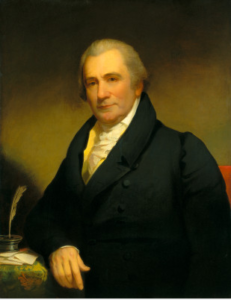
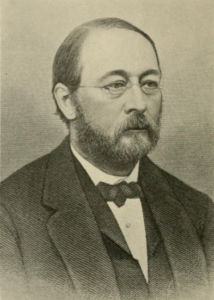 When the “Homestead” was razed in 1961. Discovered during demolition was the locally famous “Lincoln” letter written by Abraham Lincoln to George Dawson Coleman, appointing Coleman to represent the United States at the London Industry of All Nations exhibition. This letter was discovered in a “hidden” office whose access was from a false bookcase.
When the “Homestead” was razed in 1961. Discovered during demolition was the locally famous “Lincoln” letter written by Abraham Lincoln to George Dawson Coleman, appointing Coleman to represent the United States at the London Industry of All Nations exhibition. This letter was discovered in a “hidden” office whose access was from a false bookcase.
ANCESTORS- NOT ALL COFFINS MADE IT TO THEIR COFFIN
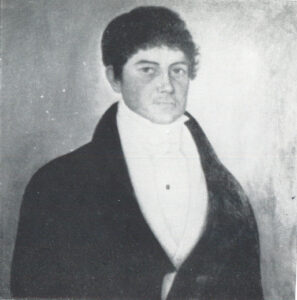
In last week’s article on the Folgers and Starbucks merger, I mentioned my wife’s ancestors the Coffin family.
The Coffin family was prominent in whaling in the United States, operating ships out of Nantucket, Massachusetts, from the 17th to 19th centuries. Some family members gained wider exposure due to their discovery of various islands in the Pacific Ocean.
Tristram Coffin, born in 1609 in England, sailed for America in 1642, settling in Newbury, Massachusetts, then moving to Nantucket. The Coffins and other Nantucket families, including the Gardners and the Starbucks, began whaling seriously in the 1690s in local waters. By 1715, the Coffin family owned three whaling ships (whalers) and a trading vessel. In 1763, six Coffin men were captains of Nantucket ships, which sailed as far as South America and Greenland.
The six Coffin captains included James J. Coffin: On May 31, 1823, the British whaler Transit arrived in Batavia, on the island of Java, having lost its master, Captain Alexander, to a whale near Christmas Island. James Coffin was on Java at the time and was appointed as captain. Later that year, while working in the central Pacific, James is said to have discovered Enderbury Island in the Phoenix group, naming it after the London whaling firm Samuel Enderby & Sons. However, when he described his discoveries of the Bonins to Arrowsmith and other geographers, he did not mention Enderbury. On September 12, 1824, he discovered the southern group of the Bonin Islands.
Another was Joshua Coffin, who, while captaining the whaler Ganges, sighted and named Gardner Island in the Phoenix Group in 1825, probably naming it after U.S. Congressman Gideon Gardner, the owner of Ganges. Alternative sources claim the whaler Joshua Gardner sighted the island and reportedly captained the Ganges in 1825.
There was Reuben Coffin who some sources report that in 1823 or 1824, he was captain of an American whaler named Transit, out of Nantucket, and was responsible for discovering the Bonin Islands. Anchoring unchallenged off Haha Jima, he claimed the islands for the United States, naming them “Coffin Islands”.
Another was Owen Coffin (1802–1821), a teenage sailor aboard the Nantucket whaler Essex when it set sail for the Pacific Ocean on a sperm whaling expedition in August 1819. In November of the following year, a whale rammed and breached their hull in mid-Pacific, causing Essex to sink. Following months in a small whaleboat, members of the near-starving crew finally concluded a member must be sacrificed. They drew lots, which Coffin “lost,” and he was shot and eaten.
Other Coffin Captains include Captain Hezekiah Coffin, whom I mentioned in the last newsletter https://gem.godaddy.com/p/5a07371
• A “Captain Coffin” was master of the whaler Baroness Longueville, sailing her on a whaling voyage between August 1816 and July 1819, returning to Britain with 600 casks.
• A “Captain Coffin”, master and part-owner of the Thule, Nantucket, after 27 months at sea, struck the “Booby Shoals” on Bellona Reefs, near the Chesterfield Islands on September 10, 1844, and was wrecked; the ship was carrying 1050 barrels of sperm oil. Two boats, crewed by 16 men, reached Moreton Bay, Queensland, on September 20, but a third boat was lost. After losing most of their possessions in the wreck, the sailors were replenished by Brisbane residents. Shipping lists show that Coffin, Mr. W. Thompson, and 13 crew members took passage from Moreton Bay on the steamer Sovereign, departing on October 4 and arriving in Port Jackson on October 8. Captain Coffin left Port Jackson on October 17 aboard the schooner Vanguard, bound for New Zealand.
• After Scotsman Robert Hunter discovered the original “Siamese twins” Chang and Eng in Siam in 1824, he partnered with Captain Abel Coffin (picture above) to sail them to America in 1829. Abel continued touring with the twins, eventually buying out Hunter’s share in the business venture. He later received letters from their manager, James Hale (see the newspaper article below).
• Records tell of a “Captain Coffin,” whose leg was severely injured in a whaling accident. With no surgeon on board, Coffin ordered his mate to cut off the leg with a knife, threatening to shoot him if he did not obey. He held the pistol, pointing at the mate throughout the operation.
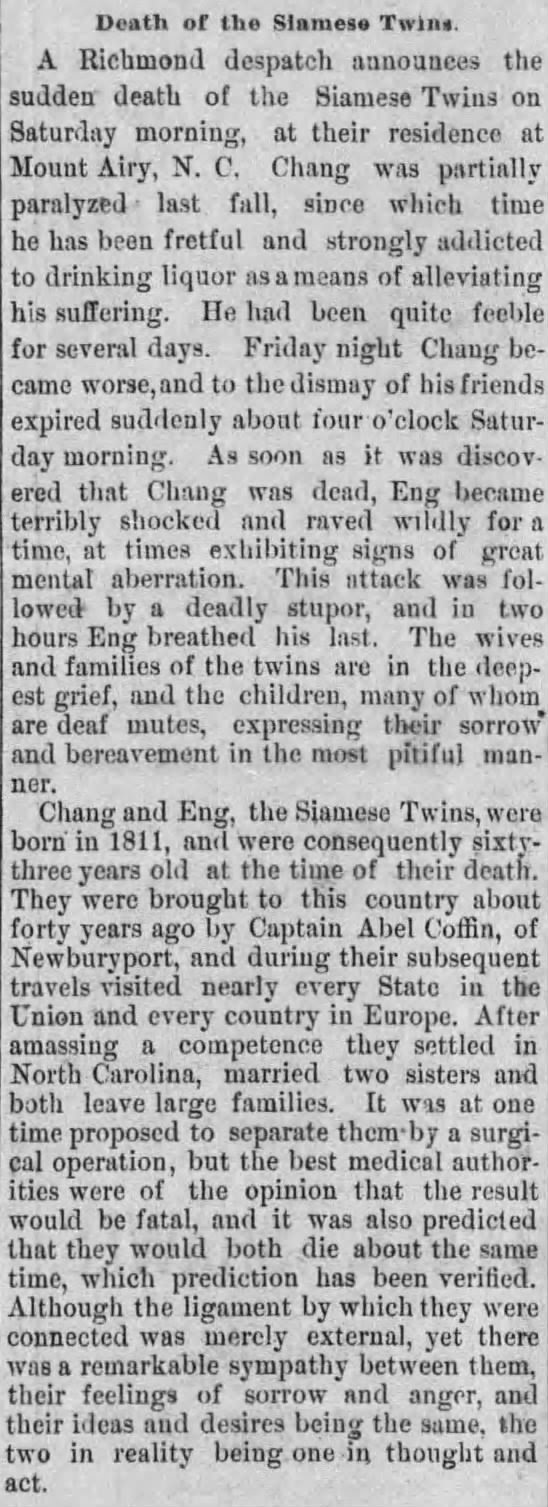
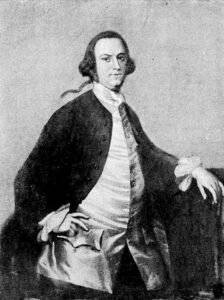
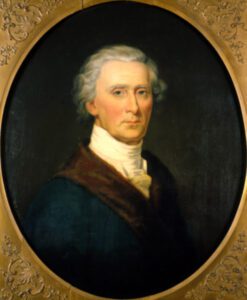
ANCESTORS- CONTINUING WITH SIGNERS OF THE DECLARATION OR THE CONSTITUTION
We have worked through all the Founding Fathers who signed the Declaration of Independence and the Constitution. So, let’s see if there are others with family ties. Charles Carroll of Carrolton signed the Declaration of Independence, and his cousin Daniel Carroll signed the Constitution.
My grandmother was a Carroll, a descendant of Anthony Carroll, supposedly a Scotsman who joined the British Navy and came to America, settling in Annapolis and later near Morgantown, WV. Since the name Carroll is hardly known in Scotland, I suspect he was an Irishman who served in the British Navy in Scotland.
The Carroll family of Charles (above left) and Daniel (above right) ancestors were the Ó Cearbhaill’s, the rulers of the Irish petty kingdom of Éile in King’s County, Ireland. Charles and Daniel’s grandfather was Charles Carroll the Settler, an Irishman from Aghagurty who moved to London in 1685 and worked as a clerk for English nobleman Lord Powis before immigrating to Maryland in October 1688. After arriving in Maryland, he settled in the colonial capital of St. Mary’s City with a commission as an attorney general from the colony’s proprietor, Lord Baltimore.
While it would be easy to conclude my Maryland Carrolls were part of this family, it’s not likely that my Carrolls were Protestant, and there were few Kings County Ireland Protestants.
Carroll’s father was Charles Carroll of Annapolis, born in Annapolis, Maryland, 1702. Though he inherited the plantation of Doughoregan Manor from his father, as a Roman Catholic, he was forbidden from participating in the political affairs of the colony.
Charles Carroll (September 19, 1737 – November 14, 1832), known as Charles Carroll of Carrollton or Charles Carroll III, was an Irish-American politician, planter, and signatory of the Declaration of Independence. He was the only Catholic signatory of the Declaration and the longest surviving, dying 56 years after its signing.
Considered one of the United States’ Founding Fathers, Carroll was known contemporaneously as the “First Citizen” of the American Colonies, a consequence of signing articles in the Maryland Gazette with that pen name. He served as a delegate to the Continental Congress and Confederation Congress. Carroll later served as the first United States Senator for Maryland. Of all of the signers of the Declaration of Independence, Carroll was reputed to be the wealthiest and most formally educated of the group. A product of his 17-year Jesuit education in France, Carroll spoke five languages fluently.
Born in Annapolis, Maryland, Carroll inherited vast agricultural estates and was regarded as the wealthiest man in the American colonies when the American Revolution commenced in 1775. His fortune at this time was reputed to be 2,100,000 pounds sterling, the equivalent to £285,023,284 in 2021 (US$375 million). In addition, Carroll presided over his manor in Maryland, a 10,000-acre estate, and claimed as his property approximately 300 slaves. Though barred from holding office in Maryland because of his religion, Carroll emerged as a leader of the state’s movement for independence. He was a delegate to the Annapolis Convention and was selected as a delegate to the Continental Congress in 1776. He was part of an unsuccessful diplomatic mission, including Benjamin Franklin and Samuel Chase, that Congress sent to Quebec in hopes of winning the support of French Canadians.
Carroll served in the Maryland Senate from 1781 to 1800. He was elected one of Maryland’s inaugural representatives in the United States Senate. Still, he resigned his seat in 1792 after Maryland passed a law barring individuals from simultaneously serving in both state and federal office. After retiring from public service, he helped establish the Baltimore and Ohio Railroad.
Daniel Carroll (July 22, 1730 – May 7, 1796) was an American politician and plantation owner from Maryland and one of the United States’ Founding Fathers. He supported the American Revolution, served in the Confederation Congress, was a delegate to the Philadelphia Convention of 1787, penned the Constitution of the United States, and was a U.S. Representative in the First Congress. Carroll was one of five men to sign the Articles of Confederation and the Constitution. He was one of the few Roman Catholics among the Founders.
Daniel was born in Marlborough Town in the Province of Maryland on July 22, 1730. He was the son of wealthy planters Daniel Carroll (c.1696 – 1751) and Eleanor Darnall Carroll (1703 – 1796). His parents’ home was Darnall’s Chance, a plantation of 27,000 acres which his mother had inherited from her grandfather. Carroll was sent abroad for his education. Between 1742 and 1748, he studied under the Jesuits at the College of St. Omer in France, established for the education of English Catholics. Then, after a tour of Europe, he sailed home and soon married Eleanor Carroll, apparently a first cousin, whose grandparents were Daniel O’Caroll and Dorothy Kennedy from Ireland. His younger brother John was the first Roman Catholic bishop in the United States (as Bishop of Baltimore, 1790) and founder of Georgetown University.
 ANCESTORS- WHAT IF YOU CALLED FOR AN AMBULANCE AND IT TOOK OVER THREE WEEKS TO GET THERE?
ANCESTORS- WHAT IF YOU CALLED FOR AN AMBULANCE AND IT TOOK OVER THREE WEEKS TO GET THERE?
I recently saw this rare Civil War Ambulance at Fort Scott, KS. https://www.nps.gov/fosc/learn/historyculture/civil-war-ambulance.htm
It reminded me of the story of my Great-Great Grandfather Henry Smith Adams, who was said to have laid under a peach tree for nine days waiting for an ambulance after being wounded in the Vicksburg campaign. Once I had the privilege of transcribing his diaries, I discovered it was 24 days later. You can read his edited (by me) diary entries over those 24 days.
Below is the only known picture of him facing forward after that day. He had to have that picture for his pension application. In all other pictures, he faced sideways.
Saturday, May 16, 1863 Weather pleasant. Raised camp near .. o’clock and marched toward Edwards Station, MS. Engaged the enemy at one o’clock. The fight was terrible, but a short time had expired till a rifle ball struck me in the right eye. I left the battlefield for a place of security.
Sunday, May 17, 1863 Weather pleasant. Considering the circumstances, have a nice shade for a resting place and accommodation. My wound is very painful but supposed not to be dangerous, yet I am compelled to keep to my bed or blanket.
Monday, May 18, 1863 Weather pleasant. I remain under the old peach tree. My wound was very sore, but doing as could be expected from such a wound. Pioneer Corps is building a hospital, and I hope soon to be removed there.
Tuesday, May 19, 1863 Weather fair. Rations are very scarce. I am living entirely off the country. Time passed slowly, and I was deprived of reading by losing my eye, but I hope I can soon read with one eye.
Wednesday, May 20, 1863 Weather fair. My eye pained me pretty seriously. We moved to the shed prepared for us. I live on soup and mush with coffee now and then hope to leave this country soon.
Thursday, May 21, 1863 Weather is pleasant, with a fine shower. Remove a part of the Rebel around parts unknown to me. My eye is pretty sore, but I hope it will get better.
Friday, May 22, 1863 Weather pleasant with a little rain. My eye pains me very much—heavy firing toward Vicksburg. The reason is unknown.
Saturday, May 23, 1863 Weather pleasant. I am still compelled to keep my bed alongside my old comrade David Munford. Battalions arrive from the front.
Sunday, May 24, 1863 Weather fair. Since rolls as usual. The weeping and mourning of the wounded make it a disagreeable place for me, yet most of them keep in good spirits.
Monday, May 25, 1863 Weather fair. Plenty of rations arrive from the Yazoo River. All the wounded that can ride on a wagon without injuring themselves are sent to the front.
Tuesday, May 26, 1863 Weather warm. We were subjected to the Rebels coming in and parole us every hour, but we were disappointed looking for ambulances to carry us to the front.
Wednesday, May 27, 1863 Weather fair. We had 50 Confederate Cavalry dashing in and placing pickets around our hospital. At the same time, one of our physicians, accompanied by a Confederate lieutenant, passed around, took every man’s name, and then the Confederates retired.
Thursday, May 28, 1863 Weather fair. My eye is doing as well as expected, yet very painful. We bury Thomas Slyter, who died of his wounds.
Friday, May 29, 1863 Weather showery. Heavy firing in the direction of Vicksburg. Gather a few huckleberries and blackberries.
Saturday, May 30, 1863 Weather showery. Very heavy firing in the direction of Vicksburg. It continued all day. My eye is very painful. I can neither lay down nor sit up with any peace or comfort.
Sunday, May 31, 1863 Weather warm. My eye is a little better. Have preaching in the forenoon. There was firing at intervals in the direction of Vicksburg.
Monday, June 1, 1863 Weather fair. My eye gains slowly. Have a charming meal of stewed plums, which are gladly received after living on hard bread and bacon for many days.
Tuesday, June 2, 1863 Weather pleasant. There is nothing to note with the same routine of duties we have each day. My eye is still gaining.
Wednesday, June 3, 1863 Weather pleasant. Pick a few blackberries. Take the part of a spectator in burying .. ….. , who died last night. Looking for the rebels and our ambulances, I can’t tell which will come first.
Thursday, June 4, 1863 Weather warm and showery. I took a stroll over the battlefield. I viewed the place I fell on the day of the fight. I also visited the graves of my comrades that fell to rise no more. Ten ambulances come and take away part of our wounded.
Friday, June 5, 1863 Weather pleasant. Rebels appear to be very numerous around our camp. I hope to be removed from this camp soon as I am tired of being hemmed in by the Rebels from the rest of mankind.
Saturday, June 6, 1863 Weather pleasant. Three companies of the 20th Mississippi come to camp and parole us. We give our name to and receive an oath from Lieutenant Heyes of the above-spoken regime. Sorrow to be paroled but can’t avoid it.
Sunday, June 7, 1863 Weather pleasant. Have an interesting time gathering and eating blackberries. I have a small piece of bone taken from my wound on the side of my head.
Monday, June 8, 1863 Weather pleasant. Forty-five ambulances arrived late in the evening to remove us. My wound is gaining slowly.
Tuesday, June 9, 1863 Weather pleasant. Get in the ambulances and start near 12 o’clock for Sherman’s landing on the Yazoo River. Take supper near sundown at Black River Bridge and immediately renew our journey.
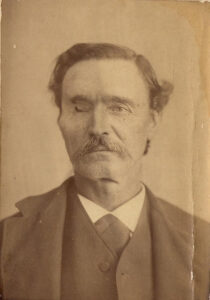
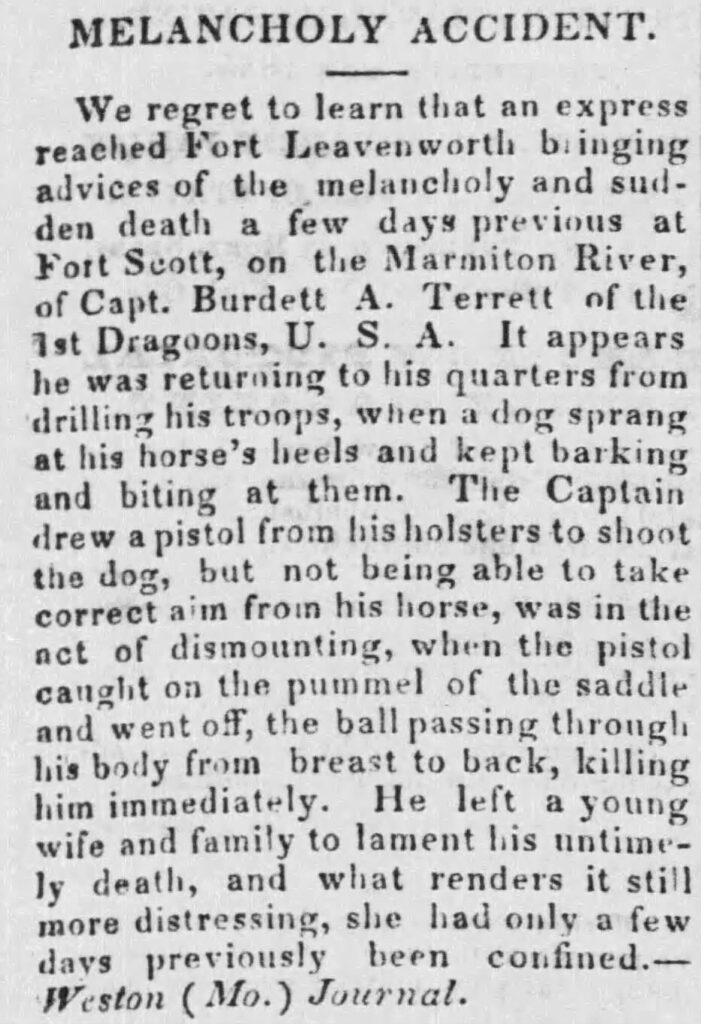
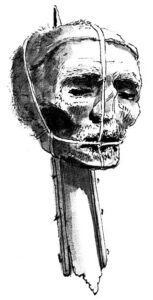
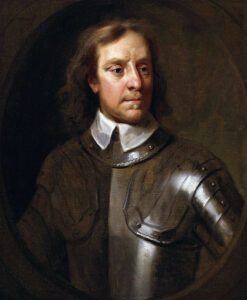
ANCESTORS- OLIVER CROMWELL’S HEAD WAS DISPLAYED ON A STAKE FOR 23 YEARS AND THEN BOUNCED AROUND FOR ANOTHER 276 YEARS
Oliver Cromwell, Lord Protector and ruler of the English Commonwealth (above left) after the defeat and beheading of King Charles I during the English Civil War, died on September 3, 1658, of natural causes. He was given a public funeral at Westminster Abbey, equal to the monarchs who came before him. His position passed to his son Richard, who was overthrown shortly afterward, leading to the re-establishment of the monarchy.
When King Charles II was recalled from exile, his new parliament, in January 1661, ordered the disinterment of the elder Cromwell’s body from Westminster Abbey, as well as those of John Bradshaw and Henry Ireton, for a posthumous execution at Tyburn. The three bodies were left hanging “from morning till four in the afternoon” before being cut down and beheaded. The heads were then placed on 20-foot (6.1 m) poles and displayed on the roof of Westminster Hall (the location of the trial of Charles I).
Cromwell’s head (above right) remained there until at least 1684. Although no firm evidence has been established for the head’s whereabouts from 1684 to 1710, tradition says that on a stormy night in the late 1680s, it was blown off from the top of Westminster Hall, thrown to the ground, and picked up by a sentry who carried it home. After it disappeared from Westminster, it was in the hands of various private collectors and museums until March 25, 1960, when it was buried at Sidney Sussex College in Cambridge, Cromwell’s alma mater.
The symbolic value of the head changed over time. Initially, it was displayed on a pole as an act of revenge by the monarchy and a warning to all who saw it. Still, by the 18th century, it had become a historical curiosity and a relic. The head has long been admired, reviled, and dismissed as a fake. Thomas Carlyle dismissed it as “fraudulent moonshine”, and scientific and archaeological analysis was carried out to test the identity after the emergence of a rival claimant to be the true head of Oliver Cromwell. Inconclusive tests culminated in a detailed scientific study by Karl Pearson and Geoffrey Morant, which concluded that there was a “moral certainty” that the head was Oliver Cromwell’s, based on a study of the head and other evidence.
You can see below that Oliver’s head was very popular.

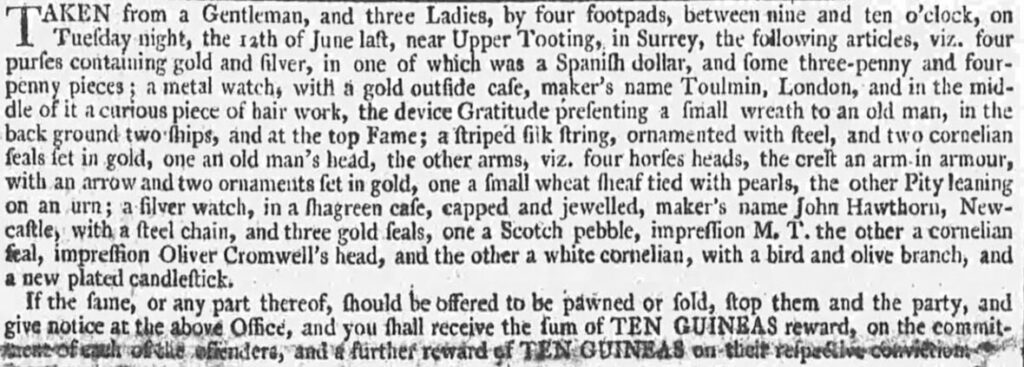
 WHAT ABOUT YOUR ANCESTORS?
WHAT ABOUT YOUR ANCESTORS?
Reach out to Dancestors to research, discover, and preserve your family history. No one is getting any younger, and stories disappear from memory every year and eventually from our potential ability to find them. Paper gets thrown in the trash; books survive! So do not hesitate and call me @ 214-914-3598.


 ANCESTORS- THE DOLLHOUSE FROM THE MANSION
ANCESTORS- THE DOLLHOUSE FROM THE MANSION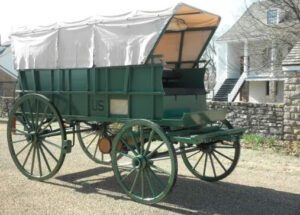 ANCESTORS- WHAT IF YOU CALLED FOR AN AMBULANCE AND IT TOOK OVER THREE WEEKS TO GET THERE?
ANCESTORS- WHAT IF YOU CALLED FOR AN AMBULANCE AND IT TOOK OVER THREE WEEKS TO GET THERE?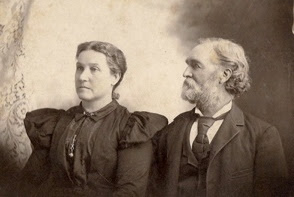 WHAT ABOUT YOUR ANCESTORS?
WHAT ABOUT YOUR ANCESTORS?